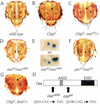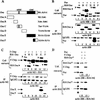Enhancer-promoter communication mediated by Chip during Pannier-driven proneural patterning is regulated by Osa
- PMID: 12629041
- PMCID: PMC196006
- DOI: 10.1101/gad.255703
Enhancer-promoter communication mediated by Chip during Pannier-driven proneural patterning is regulated by Osa
Abstract
The GATA factor Pannier activates proneural achaete/scute (ac/sc) expression during development of the sensory organs of Drosophila through enhancer binding. Chip bridges Pannier with the (Ac/Sc)-Daughterless heterodimers bound to the promoter and facilitates the enhancer-promoter communication required for proneural development. We show here that this communication is regulated by Osa, which is recruited by Pannier and Chip. Osa belongs to Brahma chromatin remodeling complexes and we show that Osa negatively regulates ac/sc. Consequently, Pannier and Chip also play an essential role during repression of proneural gene expression. Our study suggests that altering chromatin structure is essential for regulation of enhancer-promoter communication.
Figures





References
-
- Brand AH, Perrimon N. Targeted gene expression as a means of altering cell fates and generating dominant phenotypes. Development. 1993;118:401–415. - PubMed
-
- Bulger M, Groudine M. Looping versus linking: Toward a model for long distance gene activation. Genes & Dev. 1999;13:2465–2477. - PubMed
-
- Calleja M, Moreno E, Pelaz S, Morata G. Visualization of gene expression in living adult Drosophila. Science. 1996;274:252–255. - PubMed
Publication types
MeSH terms
Substances
LinkOut - more resources
Full Text Sources
Molecular Biology Databases
